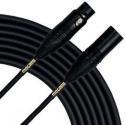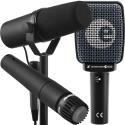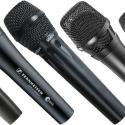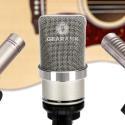What Does XLR Stand For? A Practical Explanation By Experts

XLR cables are widely used, but interestingly it's hotly debated what the three letters stand for. So what does XLR stand for?
For some, XLR stands for External Line Return. They are found in most modern audio devices, precisely top quality or professional equipment. They are also used for lighting control.
But knowing the acronym isn't enough to understand what an XLR connector is. Here, we will explain what the term means, what the technology means, and the pros and cons of this cable.
What Is An External Line Return Cannon Plug?
XLR connectors are a type of electrical connector. They are mainly used in audio.
These devices are always cylindrical and will have 3 to 7 pins inside.
They are used to create balanced microphone or audio interconnections.
What Is Balanced Audio?
Balanced audio results from two conductors with opposite polarities delivering a signal that is then reversed at the end to cancel out the noise between them. It's the method of connecting your different audio equipment without creating electromagnetic interference or static sound.
You often need a balanced audio device, like an XLR cable, to transmit audio data over extended distances and retain quality.
So, how is this connected to the pins?
The first pin is known as the shield wire or the ground wire. It stops the second and third pins from receiving electromagnetic interference.
The second pin copies the audio signal. It does this through a positive polarity.
The third pin carries the negative polarity.
The microphone will produce the same amplitude in pins 3 and 2. However, one will have a negative polarity and the other a positive one.
Once the polarity of one of the pins is reversed, the signal doubles in amplitude, and the difference between them, the noise, is then canceled.
How Do XLR Connectors Work?
When the microphone captures an audio signal, the negative and positive signals travel through the cable to the next device (usually an amplifier).
However, your next device will likely already have a preamplifier built-in. The preamplifier has a differential amplifier too. This extra mechanism resolves the difference between the balanced cable. This means it cancels out the difference between the two pins while retaining the signal.
This process is called the Common-Mode Rejection or CMR and is the secondary method of removing interference. CMR helps to remove around 60 Hz hum and is perfect for very long cable runs.
Connecting A Microphone Via XLR
Most professional microphones will have an XLR output built-in. Generally speaking, it will be a three-pin XLR and require an XLR cable to power.
Typically, the microphones use a male XLR connector, while microphone inputs (such as amps, mixing consoles, etc.) use a female connector. We will explain the differences in more detail later on.
Connecting the microphones is easy. Slot the plug into the socket, then connect the cable to a power source.
Protecting The Microphones
Another big reason why professionals opt for the XLR cable is due to its protection features.
Electrical damage used to be a common issue before XLRs came along. A grounding technique removed this issue and significantly impacted the overall sound.
To understand how an XLR connector could protect your microphones, you must first know how electricity affects the audio devices.
This means understanding the term "Phantom power." Phantom power is the process of delivering a direct current. For example, if the power supplies come from batteries, moving the power from the battery to the microphone is called phantom power.
The phantom power must be +48 volts (DC) to power professional audio devices such as headsets and microphones. This power should be sent from the device preamplifier to the microphone. This will activate the microphone's circuit.
When the +48 volts hits the XLRs, the signal isn't lost. It doesn't affect the signal at all. This is why the phenomenal is called "phantom" power.
So, what does this have to do with protection?
There isn't an unbalanced microphone signal because the plugs can hold power without interference. Because there isn't an unbalanced microphone signal, you won't receive unexpected shocks, and the interference won't damage the devices.
Why The XLR Connector's Design Matters
The XLR connectors will come in "male" or "female" designs, a somewhat crude way to describe its shape. They are described as "plugs" and "sockets." It means the cable has holes ready for a pin or hooks that need to connect to spots.
The male XLR connector will have pins, and the female connector will have holes.
These connectors will also come in two shapes - cable or chassis. This means you have 4 varieties of XLR connectors, one pair to transmit audio through a long distance and another to send audio to a locked location.
Some people falsely believe that all mounted or chassis ground XLR connectors are socket or female connectors, but XLR cables and chassis' can be either male or female. This makes it easier to connect your cables, no matter the room length.
When the female contacts the male XLR connector, it will lock on with pin 1. This is the longest pin in the device, known as the ground pin or earth pin.
Pin 1 is designed as a safety feature and will prevent the crackle of static from popping up. Then, the other two pins (or more) will be pushed into place, creating a solid connection.
All Pins And Their Uses
XLR3s Or Three-Pin
You are more likely to find a three-pin XLR connector than anything else. They are standard for most audio equipment, from home to professional microphones.
These connectors were so popular that they were often used for loudspeaker connection.
However, most professionals have switched to Speakon connectors because of better shielding. A cable shield is a conductive layer around the cable's wire. This acts as an electromagnetic shield and aids in sound balance.
3 pin connectors (as can be seen in some mini XLR connectors) are primarily used to connect power to speakers but are used in most large electronic devices—even mobility scooters.
As you already know, pin 1 is a ground pin. The other two pins have different uses depending on which country you're in. Europe considers pin 2 the hot pin and pin 3 the cold. In comparison, vintage US devices had swapped the hot and cold method. So, pin 3 is hot, and pin 2 is cold. This is an outdated practice; most US devices use the European style.
Either way, pin 2 and pin 3 should never touch pin 1 or the cable shield if they touch. You could experience a mild shock or break the equipment.
These connectors can carry a current capacity of 15 amps and accept 14 AWG.
XLR4s Or Four-Pin
In a 4-pin XLR connector, the first three jobs are the same. You'll have a ground pin and two other pins needed for a signal and power. The fourth pin is used for the LED lighting. It tells the user that the machines or microphones are on.
The fourth pin is also designed to balance the audio of headphones. This is especially important when there is no ground wire between two channels.
The fourth pin is also used as a 12-volt nominal point.
Although the 4-pin XLR was often used on professional microphones, video electronics cabling applications, and other professional audio devices, they are considered unnecessary for most modern technology.
XLR5s Or Five-Pin
The 5-pin XLR connector is still the standard for professional lighting controls. Stage lighting equipment often has a lot of data changing constantly through a set. It must redirect light at the right time while connecting to multiple outputs.
The first three pins are normal but pins 4 and 5 feed back the diagnostic data. Depending on the set, these pins may not be used. Most professionals would buy the additional pinned XLRs instead for a balanced connection.
When XLR connectors are used for DC power supplies, they often change their pin configuration. Instead, pins 1 and 2 will become chassis ground pins and power ground pins. Pin 3 becomes the positive polarity (usually 15 volts), and pin 4 becomes the negative polarity (standard -15 volts). The 5th pin then takes on the role of Phantom Power Voltage (usually 48 volts).
XLR6s And 7s Or Six-Pin And Seven-Pin
These pin types are rare and hardly ever seen. They were initially used as connectors for wired intercom studios (specifically broadcasting studios) and balancing professional microphones.
The History Behind The XLR
The XLR connector was initially called the Cannon Plug or the Cannon X Connector by ITT Cannon Electric, a Los Angeles based company. It was invented by James H. Cannon (hence the name) back in the 1940s. By 1950, the Cannon X connector series had expanded and became more extensive. Now named Cannon XL, the size wasn't the only change.
This new version of the XLR had synthetic rubber insulation, a new technological development at the time. This type of resilient rubber was initially used for shoes, not electronics.
The addition of rubber meant microphone users had a safer relationship with their microphones, and the equipment wasn't wearing out as quickly.
Cannon eventually wanted to make microphones smaller. But he needed a smaller connector for that dream to become a reality. They added a latching mechanism that allowed the microphone to move around without disconnecting from the cables. When you want to disconnect the microphone, you unclasp the latch.
Without this latching mechanism, they couldn't make the microphones smaller and keep the same crystal clear sound.
The XLR range was initially meant to describe a cable with plastic insulation instead of a rubber one. However, as time has passed, XLR has come to refer to all cable variants.
XLR cables are now used in a wide variety of applications, including stereo microphones, condenser microphones
The Advantages And Disadvantages Of An XLR Connector
So now you know what the pins mean, how an XLR connector works, and why all this information matters. So, how do XLR connectors affect your microphones?
Advantages
XLR microphones and XLR cables will give you superior audio signals. It can bring the signal to a great range without interference.
XLR cables can be customized in length and plug quality.
XLR connectors are designed to be durable. They can withstand much damage and are easy to repair and replace.
Disadvantages
The biggest issue that most people have with XLR microphones or XLR cables is the price. The cost of running multiple XLR cables and devices for large setups can add up to a lot.
Even if you can afford an XLR microphone, it might not be compatible with the rest of your audio equipment. You will need a mixer with an XLR input or an audio interface to use XLR mics.
Portability can be an issue if you're using an XLR setup. For some situations, a USB microphone would be better for portability.
Pro audio devices like studio monitors only take in XLR mic inputs as RCA cables are unbalanced and can introduce noise. This may be a problem if you're using a mix of modern and vintage gear that may still use RCA as a connector.
What Does XLR Stand For - Final Thoughts
XLR cables and plugs are one of the most durable and versatile connectors. They are the standard for microphones, studio, and pro audio gear. Understanding the history and nature of balanced audio can help you put these cables to good use, and diagnose any problems that you may encounter.
In your exploration of XLR cables and its significance in audio connections, you should now get a grasp on how XLR cables differ from TS and TRS counterparts.












